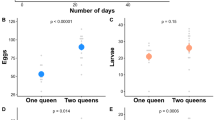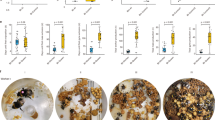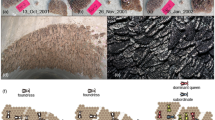Abstract
An important transition in insect life-history evolution was the shift from a solitary existence to living in groups comprising specialized castes. Caste-forming species produce some individuals that reproduce and others with worker functions that have few or no offspring1. Morphologically specialized castes are well known in eusocial species like ants and termites1, but castes have also evolved in less-studied groups like thrips, aphids and polyembryonic wasps2,3,4,5. Because selection acts at both the individual and the colony level, ratios of investment in different castes are predicted to vary with environmental factors like competition and resources6,7,8. However, experimental evidence for adaptive shifts in caste ratios is limited9 owing to the experimental difficulty of manipulating factors thought to influence caste ratios10,11,12,13, and because some species produce behaviourally flexible castes that switch tasks in response to colony needs14,15. Unlike other caste-forming species, the broods of polyembryonic wasps develop clonally, so that increased production of one caste probably results in decreased production of the other16. Here we show that the polyembryonic wasp Copidosoma floridanum alters caste ratios in response to interspecific competition. Our results reveal a distinct trade-off by C. floridanum between reproduction and defence, and show experimentally that caste ratios shift in an adaptive manner.
This is a preview of subscription content, access via your institution
Access options
Subscribe to this journal
Receive 51 print issues and online access
$199.00 per year
only $3.90 per issue
Buy this article
- Purchase on Springer Link
- Instant access to full article PDF
Prices may be subject to local taxes which are calculated during checkout



Similar content being viewed by others
References
Robinson, G. E. Regulation of division of labor in insect societies. Annu. Rev. Entomol. 37, 637–665 ( 1992).
Crespi, B. J. Eusociality in Australian gall thrips. Nature 359, 724–726 (1992).
Stern, D. L. & Foster, W. A. The evolution of soldiers in aphids. Biol. Rev. 71, 27–79 (1996).
Cruz, Y. P. A sterile defender morph in a polyembryonic hymenopterous parasite. Nature 294, 446–447 ( 1981).
Grbic, M., Ode, P. J. & Strand, M. R. Sibling rivalry and brood sex ratios in polyembryonic wasps. Nature 360, 254– 256 (1992).
Oster, G. & Wilson, E. O. Caste and Ecology in the Social Insects (Princeton Univ. Press, Princeton, 1978).
Herbers, J. M. On caste ratios in ant colonies: population responses to changing environments. Evolution 14, 575–585 (1980).
Hasegawa, E. The optimal caste ratio in polymorphic ants: estimation and empirical evidence. Am. Nat. 149, 706–711 (1997).
Passera, L., Roncin, E., Kaufmann, B. & Keller, L. Increased soldier production in ant colonies exposed to intraspecific competition. Nature 379, 630–631 ( 1996).
Johnston, A. B. & Wilson, E. O. Correlates of variation in the major/minor ratio of the ant, Pheidole dentata (Hymenoptera: Formicidae). Ann. Entomol. Soc. Am. 78, 8–11 (1985).
Hasegawa, E. Nest defense and early production of the major workers in the dimorphic ant Colobopsis nipponicus (Wheeler) (Hymenoptera: Formicidae). Behav. Ecol. Sociobiol. 33, 73–77 (1993).
Wilson, E. O. The relation between caste ratios and division of labor in the ant genus Pheidole (Hymenoptera: Formicidae). Behav. Ecol. Sociobiol. 16, 89–98 ( 1984).
Beshers, S. N & Traniello, J. F. The adaptiveness of worker demography in the attine ant Trachymyrmex septentrionalis. Ecology 75, 763–775 ( 1994).
Gordon, D. M. Group-level dynamics in harvester ants: young colonies and the role of patrolling. Anim. Behav. 35, 833–843 (1987).
Gordon, D. M. Dynamics of task switching in harvester ants. Anim. Behav. 38, 194–204 (1989).
Strand, M. R. & Grbic, M. The development and evolution of polyembryonic insects. Curr. Top. Dev. Biol. 35, 121– 159 (1997).
Strand, M. R. Oviposition behavior and progeny allocation of the polyembryonic wasp Copidosoma floridanum (Hymenoptera: Encyrtidae). J. Insect Behav. 2, 355–368 ( 1989).
Ode, P. J. & Strand, M. R. Progeny and sex allocation decisions of the polyembryonic wasp, Copidosoma floridanum. J. Anim. Ecol. 64, 213–224 ( 1995).
Browning, H. W. & Oatman, E. R. Intra- and interspecific relationships among some parasites of Trichoplusia ni. Environ. Entomol. 13, 551–556 (1984).
Strand, M. R., Johnson, J. A. & Culin, J. D. Intrinsic, interspecific competition between the polyembryonic parasitoid, Copidosoma floridanum and solitary endoparasitoid Microplitis demolitor in Pseudoplusia includens. Entomol. Exp. Appl. 55, 275–284 ( 1990).
Godfray, H. C. J. Parasitoids: Behavioral and Evolutionary Ecology (Princeton Univ. Press, Princeton, 1994).
Wheeler, D. E. The developmental basis of worker caste polymorphism in ants. Am. Nat. 138, 1218–1238 (1991).
Grbic, M,, Nagy, L. M. & Strand, M. R. Development of polyembryonic insects: a major departure from typical insect embryogenesis. Dev. Genes Evol. 208, 69–81 (1998).
Baehrecke, E. H., Aiken, J. M., Dover, B. A. & Strand, M. R. Ecdysteroid induction of embryonic morphogenesis in a parasitic wasp. Dev. Biol. 158, 275–287 (1993).
Grbic, M., Rivers, D. & Strand, M. R. Caste formation in the polyembryonic wasp Copidosoma floridanum (Hymenoptera: Encyrtidae): in vivo and in vitro analysis. J. Insect Physiol. 43, 553–565 (1997).
Strand, M. R. & Pech, L. L. Immunological basis for compatibility in parasitoid-host relationships. Annu. Rev. Entomol. 40, 31–56 (1995).
Strand, M. R., Witherell, R. A. & Trudeau, D. Two Microplitis demolitor polyDNAvirus mRNAs expressed in hemocytes of Pseudoplusia includens contain a common cysteine-rich domain. J. Virol. 71, 2146– 2156 (1997).
Webb, B. A. in The Insect Viruses (eds Miller, L. K. & Ball, A. L.) 105– 139 (Plenum, New York, 1998).
Acknowledgements
We thank J. Johnson for assistance during the study, M. Grbic for discussions, and M. Visser, F. Wackers and W. van der Putten for comments on an early draft of the manuscript. This work was supported by the NSF.
Author information
Authors and Affiliations
Corresponding author
Rights and permissions
About this article
Cite this article
Harvey, J., Corley, L. & Strand, M. Competition induces adaptive shifts in caste ratios of a polyembryonic wasp. Nature 406, 183–186 (2000). https://doi.org/10.1038/35018074
Received:
Accepted:
Issue Date:
DOI: https://doi.org/10.1038/35018074
This article is cited by
-
Evolution, phylogenetic distribution and functional ecology of division of labour in trematodes
Parasites & Vectors (2019)
-
The effects of disturbance threat on leaf-cutting ant colonies: a laboratory study
Insectes Sociaux (2017)
-
Decreasing worker size diversity does not affect colony performance during laboratory challenges in the ant Temnothorax nylanderi
Behavioral Ecology and Sociobiology (2017)
-
Sexual complementarity between host humoral toxicity and soldier caste in a polyembryonic wasp
Scientific Reports (2016)
-
Geographic variation in caste ratio of trematode colonies with a division of labour reflect local adaptation
Parasitology Research (2014)
Comments
By submitting a comment you agree to abide by our Terms and Community Guidelines. If you find something abusive or that does not comply with our terms or guidelines please flag it as inappropriate.



